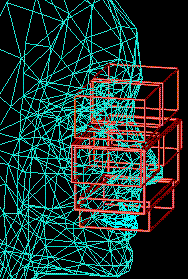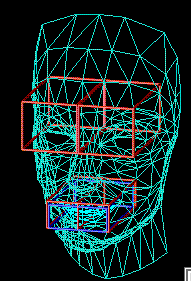
| 
|

| 
|
Psychological research has classfied six facial expressions which correspond to distinct universal emotions: disgust, sadness, happiness,fear,anger, surprise[Black,Yacoob,95]. It is interesting to note that four out of the six are negative emotions. We have generalized the cues for facial expression as suggested by Ekman and Friesen in the table below. We create all expressions via applying a sequential combination of linear or sphincter muscles over the appropriate bounding boxes. We drop the jaw open by applying the linear muscle over a bounding box around the lower jaw. The bounding boxes for disgust(left) and anger(right) are shown above in red for linear muscles, and blue for the sphincter muscles.
| EXPRESSION | MOTION CUES | PSEUDO-MUSCLES USED | |||||||||
| Happiness | raising and lowering of mouth corners | 6 linear muscles | |||||||||
| Sadness | lowering of mouth corners
raise inner portion of brows | 6 linear muscles | |||||||||
Surprise
| brows arch | eyes open wide to expose more white jaw drops slightly 3 linear muscles
| Fear
| brows raised | eyes open mouth opens slightly 5 linear muscles | 1 sphincter for the mouth Disgust
| upper lip is raised | nose bridge is wrinkled cheeks raised 6 linear muscles
| Anger
| brows lowered | lips pressed firmly eyes bulging 4 linear muscles | 1 sphincter for the mouth |
What remains beyond this point is the result of a trial-and-error process as time permitted to produce the most convincing animations.

| 
| 
|
| sadness Mpeg | hapiness Mpeg | disgust Mpeg |

| 
| 
|
| fear Mpeg | surprise Mpeg | anger Mpeg |
In addition, any of the above expressions can be emphasized with dilating or contracting pupils, shifting and rolling eyes.